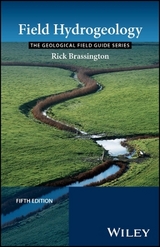
Field Hydrogeology
Wiley-Blackwell (Verlag)
978-1-118-39736-7 (ISBN)
- Titel erscheint in neuer Auflage
- Artikel merken
With case studies and text boxes to aid comprehension, and a particular emphasis on practical application, this is an essential tool for students taking Hydrogeology and/or field course modules in Geology, Earth Sciences, Hydrogeology and Engineering courses.
Rick Brassington Consultant Hydrogeologist. He worked in the UK public water industry for some 24 years before moving into consultancy. He was employed at director level in three major companies before setting up his own consultancy in 1998. He has also been the Visiting Professor of Hydrogeology in the School of Civil Engineering and Geosciences at Newcastle University since 2007.
Preface xi
Acknowledgements xiii
1 Introduction 1
1.1 Groundwater Systems 1
1.2 Conceptual Model 5
1.3 Groundwater Computer Modelling 11
1.4 Hydrogeological Report Writing 12
1.5 Expert Witness 14
2 Desk Study 17
2.1 Defining the Area 18
2.2 Identifying the Aquifers 18
2.3 Groundwater Levels 20
2.4 Surface Water 21
2.5 Recharge 21
2.6 Groundwater Use 23
2.7 Groundwater Chemistry 24
2.8 Aerial Photographs and Satellite Imagery 25
2.9 Planning a Fieldwork Programme 28
3 Field Evaluation of Aquifers 29
3.1 Grain Size Analysis 29
3.2 Hydraulic Properties of Aquifers 32
3.3 Hydraulic Properties and Rock Types 35
3.4 Assessing Hydraulic Properties 42
3.5 Using Hydraulic Property Information 44
4 Groundwater Levels 49
4.1 Water-Level Dippers 49
4.2 Continuous Water-Level Recorders 55
4.3 Measuring Ground Levels and Locations 60
4.4 Tool-Box 64
4.5 Well Catalogue 66
4.6 Field Surveys for Wells, Boreholes and Springs 66
4.7 Interpretation of Abstraction Borehole Water Levels 73
4.8 Groundwater-Level Monitoring Networks 82
4.9 Groundwater-Level Fluctuations 84
4.10 Managing Groundwater-Level Data 93
4.11 Constructing Groundwater Contour Maps and Flow Nets 94
4.12 Interpretation of Contour Maps and Flow Nets 96
4.13 Using Other Groundwater Information 99
5 Rainfall, Springs and Streams 102
5.1 Precipitation 102
5.2 Evaporation 107
5.3 Springs 109
5.4 Stream-Flow Measurement 117
5.5 Stage–Discharge Relationships 130
5.6 Choosing the Best Method 132
5.7 Processing Flow Data 132
6 Pumping Tests 135
6.1 What Is a Pumping Test? 135
6.2 Planning a Pumping Test 136
6.3 Pumps and Pumping 136
6.4 On-Site Measurements 142
6.5 Pre-Test Monitoring 148
6.6 Test Set-up 149
6.7 Step Tests 150
6.8 Constant Rate Tests 152
6.9 Recovery Tests 153
6.10 Pumping Test Analysis 154
6.11 Tests on Single Boreholes 164
6.12 Packer Tests 169
7 Groundwater Chemistry 172
7.1 Analytical Suites and Determinands 172
7.2 Sampling Equipment 174
7.3 Sampling Protocols 188
7.4 Monitoring Networks 199
7.5 Using Chemical Data 200
8 Recharge Estimation 205
8.1 Water Balance 205
8.2 Rainfall Recharge 206
8.3 Induced Recharge 211
8.4 Other Sources of Recharge 213
9 Specialist Techniques 215
9.1 Borehole and Piezometer Installation 215
9.2 Down-Hole Geophysics 223
9.3 Using Artificial Tracers 229
10 Practical Applications 237
10.1 Borehole Prognoses 237
10.2 Groundwater Supplies 238
10.3 Wells in Shallow Aquifers 244
10.4 Contaminated Land Investigations 245
10.5 Landfills and Leachate 248
10.6 Geothermal Energy 251
10.7 Groundwater Lowering by Excavation 253
10.8 Rising Water Tables 258
10.9 Soakaways 260
10.10 Investigating Wetland Hydrology 260
A Good Working Practice 263
A1.1 Safety Codes 263
A1.2 Safety Clothing and Equipment 263
A1.3 Distress Signals 265
A1.4 Exposure or Hypothermia 265
A1.5 Heat Exhaustion 265
A1.6 Working Near Wells, Boreholes and Monitoring Piezometers 266
A1.7 Hygiene Precautions for Water Supplies 266
A1.8 Trial Pits 267
A1.9 Electrical Equipment 267
A1.10 Filling Fuel Tanks 267
A1.11 Waste Disposal Sites 267
A1.12 Stream Flow Measurement 268
B Conversion Factors 269
References and Further Reading 274
Index 281
| Erscheinungsdatum | 28.04.2017 |
|---|---|
| Reihe/Serie | Geological Field Guide |
| Verlagsort | Hoboken |
| Sprache | englisch |
| Maße | 114 x 178 mm |
| Gewicht | 318 g |
| Themenwelt | Naturwissenschaften ► Geowissenschaften ► Hydrologie / Ozeanografie |
| ISBN-10 | 1-118-39736-3 / 1118397363 |
| ISBN-13 | 978-1-118-39736-7 / 9781118397367 |
| Zustand | Neuware |
| Informationen gemäß Produktsicherheitsverordnung (GPSR) | |
| Haben Sie eine Frage zum Produkt? |
aus dem Bereich



